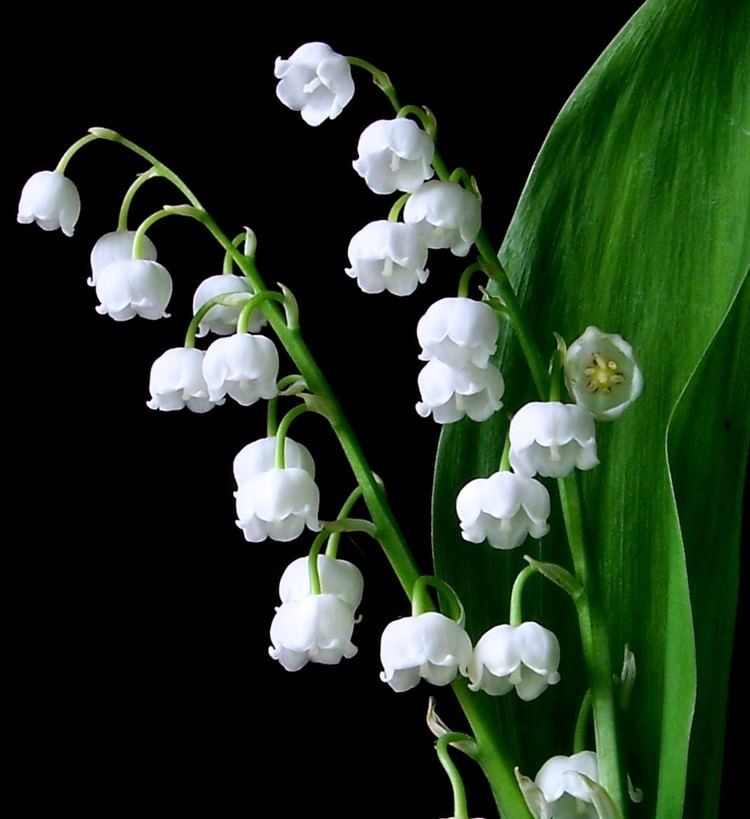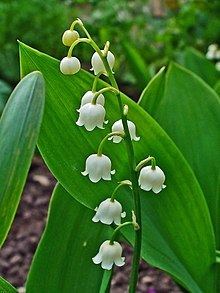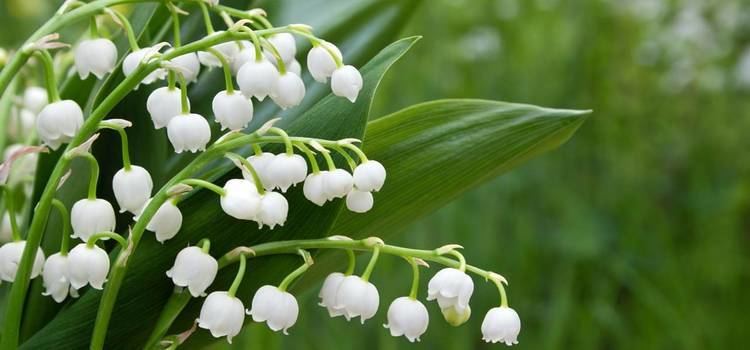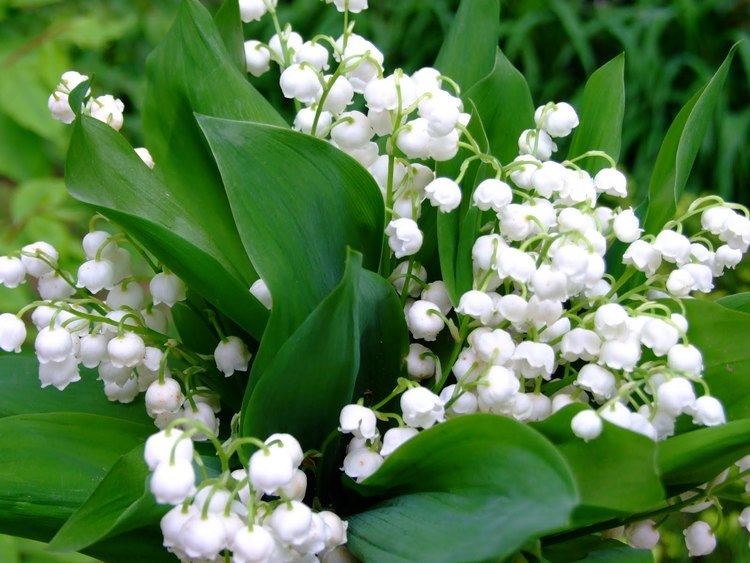Higher classification Convallaria | Rank Species | |
 | ||
Similar Convallaria, Lily, Snowdrop, Hyacinth, Larkspur | ||
Toxic impostor plant lily of the valley and allium species
Lily of the valley, sometimes written lily-of-the-valley, scientific name Convallaria majalis /ˌkɒnvəˈleɪriə məˈdʒeɪlᵻs/, is a sweetly scented, highly poisonous woodland flowering plant that is native throughout the cool temperate Northern Hemisphere in Asia, and Europe.
Contents
- Toxic impostor plant lily of the valley and allium species
- How to plant lily of the valley convallaria
- Description
- Distribution
- Ecology
- Taxonomy
- Garden use
- Chemistry
- Christian legend
- Other names and legends
- Use in weddings
- Symbolic uses
- References

It is possibly the only species in the genus Convallaria (or one of two or three, if C. keiskei and C. transcaucasica are recognised as separate species). In the APG III system, the genus is placed in the family Asparagaceae, subfamily Nolinoideae (formerly the family Ruscaceae). It was formerly placed in its own family Convallariaceae, and, like many lilioid monocots, before that in the lily family Liliaceae.

How to plant lily of the valley convallaria
Description

Convallaria majalis is a herbaceous perennial plant that forms extensive colonies by spreading underground stems called rhizomes. New upright shoots are formed at the ends of stolons in summer, these upright dormant stems are often called pips. These grow in the spring into new leafy shoots that still remain connected to the other shoots under ground, often forming extensive colonies. The stems grow to 15–30 cm tall, with one or two leaves 10–25 cm long; flowering stems have two leaves and a raceme of 5–15 flowers on the stem apex.

The flowers have six white tepals (rarely pink), fused at the base to form a bell-shape, 5–10 mm diameter, and sweetly scented; flowering is in late spring, in mild winters in the Northern Hemisphere it is in early March. The fruit is a small orange-red berry 5–7 mm diameter that contains a few large whitish to brownish colored seeds that dry to a clear translucent round bead 1–3 mm wide. Plants are self-sterile, and colonies consisting of a single clone do not set seed.
Distribution
Convallaria majalis is a native of Europe, where it largely avoids the Mediterranean and Atlantic margins. An eastern variety, C. majalis var. manschurica occurs in Japan and parts of eastern Asia. A limited native population of C. majalis var. montana occurs in the Eastern United States . There is, however, some debate as to the native status of the American variety.
Like many perennial flowering plants, C. majalis exhibits dual reproductive modes by producing offspring asexually by vegetative means and by seed, produced via the fusion of gametes.
Ecology
Convallaria majalis is a plant of partial shade, and mesophile type that prefers warm summers. It likes soils that are silty or sandy and acid to moderately alkaline, with preferably a plentiful amount of humus. The Royal Horticultural Society states that slightly alkaline soils are the most favoured. It is an Euroasiatic and suboceanic species that lives in mountains up to 1,500 m altitude.
Convallaria majalis is used as a food plant by the larvae of some Lepidoptera species including the grey chi. Adults and larvae of the leaf beetle Lilioceris merdigera are also able to tolerate the cardenolides and thus feed on the leaves.
Taxonomy
There are three varieties that have sometimes been separated out as distinct species or subspecies by some botanists.
Convallaria transcaucasica is recognised as a distinct species by some authorities, while the species formerly called Convallaria japonica is now classified as Ophiopogon japonicus.
Garden use
Convallaria majalis is sometimes grown in gardens for its scented flowers and ground-covering abilities in shady locations. It has gained the Royal Horticultural Society's Award of Garden Merit. In favourable conditions it can form large colonies.
Various kinds and cultivars are grown, including those with double flowers, rose-colored flowers, variegated foliage and ones that grow larger than the typical species.
Traditionally Convallaria majalis has been grown in pots and winter forced to provide flowers during the winter months, both for as potted plants and as cut flowers.
Chemistry
All parts of the plant are highly poisonous, including the red berries which may be attractive to children. If ingested—even in small amounts—the plant can cause abdominal pain, vomiting, reduced heart rate, blurred vision, drowsiness, and red skin rashes.
Roughly 38 different cardiac glycosides (cardenolides) have been found in the plant, some among others:
The plant also contains saponins. Although deadly, the plant has been used as a folk remedy in moderate amounts, and is currently used by herbalists as a restricted herbal remedy. It also contains the unusual, poisonous amino acid azetidine-2-carboxylic acid.
The odor of lily of the valley, specifically the ligand bourgeonal, attracts mammalian sperm. The 2003 discovery of this phenomenon prompted research into odor reception, but a 2012 study demonstrated instead that at high concentrations, bourgeonal imitated the role of progesterone in stimulating sperm to swim (chemotaxis), a process unrelated to odor reception.
Christian legend
The flower is also known as Our Lady's tears or Mary's tears from Christian legends that it sprang from the weeping of the Virgin Mary during the crucifixion of Jesus. Other etiologies have its coming into being from Eve's tears after she was driven with Adam from the Garden of Eden or from the blood shed by Saint Leonard of Noblac during his battles with a dragon.
The name "lily of the valley" is used in some English translations of the Bible in Song of Songs 2:1, but the Hebrew phrase "shoshannat-ha-amaqim" in the original text (literally "lily of the valleys") does not refer to this plant. It is possible, though, that the biblical phrase may have had something to do with the origin or development of the modern plant-name.
It is a symbol of humility in religious painting. Lily of the valley is considered the sign of Christ's second coming. The power of men to envision a better world was also attributed to the lily of the valley.
Other names and legends
Other names include May lily, May bells, and muguet (French). In Bulgarian and Macedonian it is called момина сълза /momina.səlza/ and момина солза respectively, meaning "lass's tear".
Its scientific name, majalis or maialis, means "of or belonging to May", and old astrological books place the plant under the dominion of Mercury, since Maia, the daughter of Atlas, was the mother of Mercury or Hermes.
In the "language of flowers", the lily of the valley signifies the return of happiness. Legend tells of the affection of a lily of the valley for a nightingale that did not come back to the woods until the flower bloomed in May.
Use in weddings
Lily of the valley has been used in weddings, although it can be very expensive. Lily of the valley was featured in the bridal bouquet at the wedding of Prince William and Catherine Middleton. Lily of the valley was also the flower chosen by Princess Grace of Monaco to be featured in her bridal bouquet.
Symbolic uses
At the beginning of the 20th century, it became tradition in France to sell lily of the valley on international labour day, 1 May (also called L. Fête du Muguet (Lily of the Valley Day) by labour organisations and private persons without paying sales tax (on that day only) as a symbol of spring. The Norwegian municipality Lunner has a lily of the valley on its coat-of-arms.
Lily of the valley was the floral emblem of Yugoslavia, and it also became the national flower of Finland in 1967.
